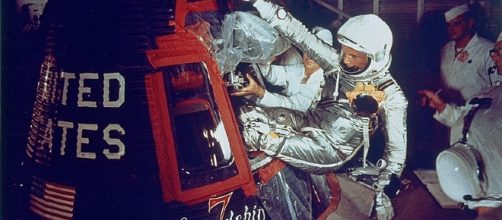Two of the singular events in the 1960s were the Apollo race to the moon and the struggle for civil rights. The two rarely intersected. One time that they did happened when the Reverend Ralph Abernathy led a protest march to the site of the launch of Apollo 11 to use the event to remind the nation of the problems of poverty, crime, and education that then as now blighted many African Americans. “Hidden Figures,” which goes into wide release on January 6 is another occasion when the struggles of African Americans met the space program. The story is both illuminating and uplifting.
Taraji Henson, Octavia Spenser, and Janelle Monae play three African American women working at NASA Langley in 1961 in the computer department. By “computer” we mean women who could work the higher math needed to send men into space and return them to Earth. Henson’s character, Katherine Johnson, is a math genius on the level of an Einstein or a Stephen Hawking. Most African American women at that time who could do science and math were consigned to be teachers at segregated schools. NASA and the space program offered them a chance to do so much more.
Mind, NASA Langley is located in Virginia, still segregated with separate bathrooms, drinking fountains, and even different sections of the public library.
The African American computers were also segregated, at least as the movie begins. “Hidden Figures” depicts a little-realized role that NASA played in putting an end to Jim Crow. Nothing was allowed to stand in the way of the singular necessity of beating the Soviets to the moon, certainly not the remnants of racism that exist still in living memory. Slowly but steadily in the course of the movie, those remnants are swept away.
To be sure, the old cliché of having to be twice as good to get half as far still adhered. But the three woman who are at the center of the film proved, to paraphrase the words of Martin Luther King, that one should not be judged by the color of one’s skin, but rather on the content of their intellect.
They had to put up with slights small and gross, but in the end, their success was America’s success in more than one way.
Kevin Costner plays a NASA supervisor who recognizes Katherine Johnson’s worth early on, even going so far as to end segregated bathrooms on site with the judicious use of a crowbar. Jim Parsons plays a version of his Sheldon Cooper character who feels put upon that Katherine Johnson is set to check his work, though she comes to respect her in the end. Kristin Dunst is a female NASA supervisor who is clueless about her innate bigotry, though she too comes around to realize the error of her ways.
The movie’s climax depicts the first orbital flight of Friendship 7, which Katherine Johnson had a critical role in.
Highly recommended.

